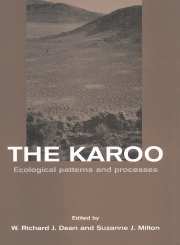Book contents
- Frontmatter
- Contents
- List of contributors
- Foreword
- Preface
- Acknowledgements
- Part one Biogeographic patterns and the driving variables
- Part two Form and function
- Part three Dynamics
- Part four Human impacts
- 15 Hunters and herders in the karoo landscape
- 16 Historical and contemporary land use and the desertification of the karoo
- 17 Alien plant invaders of the karoo: attributes, impacts and control
- Part five Comparisons
- References
- Index
17 - Alien plant invaders of the karoo: attributes, impacts and control
Published online by Cambridge University Press: 23 December 2009
- Frontmatter
- Contents
- List of contributors
- Foreword
- Preface
- Acknowledgements
- Part one Biogeographic patterns and the driving variables
- Part two Form and function
- Part three Dynamics
- Part four Human impacts
- 15 Hunters and herders in the karoo landscape
- 16 Historical and contemporary land use and the desertification of the karoo
- 17 Alien plant invaders of the karoo: attributes, impacts and control
- Part five Comparisons
- References
- Index
Summary
Introduction
Some alien plants, including Ricinus communis and Medicago polymorpha, have been established in the karoo since the late Stone Age period (Deacon, 1986b), but none of these early colonizers has ever become particularly dominant or problematic. Apart from a prickly pear, Opuntia ficus-indica, which was probably introduced into South Africa before 1656 (Wells et al., 1986), the invasion of the karoo really commenced when many livestock farmers migrated northwards from the western Cape during the 1800s (Hoffman et al., this volume), inadvertently carrying with them seeds of several alien plant species. Disturbances caused by the newly settled farmers and their livestock created conditions that favoured the establishment of alien plants, predominantly annual, nonwoody shrubs and herbaceous species such as Argemone ochroleuca (s.n. A. subfusiformis) and Salsola kali (Table 17.1).
The situation worsened with time because the landowners tried to recreate the home environment they had left and they began to introduce trees and shrubs in an otherwise almost treeless environment (Table 17.2). They propagated species that would provide fodder, shade, fuel and protection. Many of the species they selected exhibit features that characterize aggressive invaders, namely, copious seed production, efficient dispersal mechanisms, xerophytic tolerances and the ability to coppice or reproduce vegetatively. Some of the introduced species thrived in the new environment and soon ‘escaped’ into the natural vegetation.
In this chapter, we consider the attributes and effects of alien plant species that have become naturalized in the Great Karoo. We concentrate on species that have formed monospecific stands over large areas. Such transformer species constitute the most serious threat to the karoo and have therefore received most attention in terms of research and control efforts.
- Type
- Chapter
- Information
- The KarooEcological Patterns and Processes, pp. 274 - 288Publisher: Cambridge University PressPrint publication year: 1999
- 6
- Cited by



